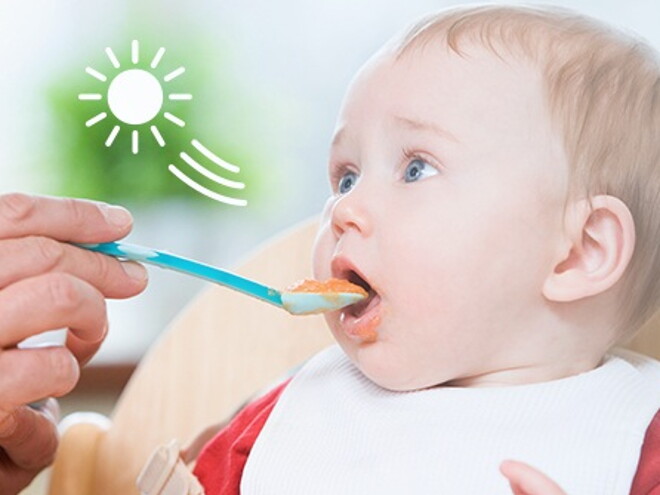
Do… feed your baby when they’re hungry
Look for signs they’re interested in food, such as opening their mouth and leaning towards the spoon you’re offering.
Don’t… keep going when she’s full
Put the spoon down when she shows you signs they’re full—this helps encourage good eating habits. They might tell you they’re full by shutting their mouth, turning their head away, or being easily distracted by other things.
Do… notice if they’re just playing
Babies explore things with their mouths. If they’re just putting the spoon into their mouth out of curiosity, as they do with toys, feeding time is probably over for now. Let them play with the spoon but put their food away.
Don’t… force her to finish the bowl
Most babies can regulate their own feeding, so don’t push them to finish their meal if they have lost interest.
Do… pack every spoonful with goodness
Babies’ tummies are tiny compared to ours, so make every mouthful count by offering nutrient-packed foods. At six to eight months of age, only around one third (about 200 calories) of your baby’s nutrition comes from complementary foods, with breast milk and/or formula supplying the rest. Every spoonful should be a step towards teaching healthy-eating habits, with meals or snacks of pureed fruits, vegetables, meats, and grains. Your baby’s need for iron is especially important now. One recent publication showed that baby cereal was part of the diet of 75% of the six- to nine-month-old babies studied from the United States. Iron-fortified baby cereal was the biggest source of iron in their diet.
Don’t… add sugar or salt
Health professionals recommend that added sugars (sugars added during manufacture, by a cook, or by you), and sugars naturally found in syrups, fruit juices, and fruit juice concentrates, should count for no more than 10% of your baby’s calories from complementary foods. Check the label when you are shopping. Offer healthy selections which contain important nutrients. There is no room for ‘sugary’ foods and sugar-sweetened beverages.
Do… offer healthy foods at regular times
Offer healthy foods at regular meal and snack times, and let your baby decide how much, if any, they’ll eat. As long as you’re giving them some balanced choices, there’s nothing to worry about. Eventually they’ll settle into a pattern of regular daily meals and snacks.
Don’t… worry if they only eat a spoonful or two
When your baby starts to eat complementary foods, they may only want a tiny amount at a time. They’re still receiving most of their calories from breast milk and/or formula. And they need time to learn how to eat from a spoon! Don’t pressure them to eat more. It’s perfectly normal for your baby’s appetite to change from day to day. Relax and go with it. “Pressuring a child to eat has been associated with a lower intake of healthy food and an overall fussiness about food,” explains Lisa Fries, PhD, Behavioral Scientist at Nestlé Research Center in Switzerland. “This pressure can make mealtimes stressful for your child and can create negative associations with the food you are offering. By keeping mealtimes relaxed, you increase the chances that they’ll try the food again next time.”
Do… gently persist with new foods
Continue to introduce a variety of fruits, vegetables, beans, meats, and grains even if you don’t get a positive reaction every time. Babies are born with a preference for sweet tastes, but that doesn’t mean sweet-tasting foods are the only foods they’ll enjoy.
Don’t… stop after one or two attempts
Your baby may need multiple ‘tastes’ (as many as eight tries, offered at different meals and on different days) of a new food as they learn to accept and like the flavour, so don’t give up. The more often you offer a new food, the more likely your little one will eventually enjoy it.
Do… pair new foods with old favourites
Try giving a food you know your baby enjoys alongside a new food. You might put a taste of both flavours on the same spoon to start with as a way to introduce the new food. Then, if it’s well received, offer the new food on its own.
Don’t… offer too many choices at one meal
Variety is important, but too many choices at one meal can overwhelm your new eater. Give them a chance to sample and accept new tastes gradually.
Do… feed her as much as she wants
Your baby will communicate with body language, facial expressions, and a wide open mouth when they are still hungry. Allow them to decide how much they want to eat.
Don’t… only give her favourites
It may be tempting, but don’t forget your job is to offer your baby a choice of healthy foods. Your baby’s job is to decide how much to eat. If they’re hungry they’ll eat other foods after their favourites are gone.
Do… watch your baby’s expressions
Your baby’s facial expression may tell you a lot about what they’re thinking, but don’t be confused. A new food may evoke a surprise response from your baby, only because it is something they have not tasted before. This does not mean that they don’t like the food. Remember, even foods that you think your baby does not prefer can become favourites with multiple tastes over several days or weeks. As always, pay attention to when your baby is showing you when they’re hungry and when they’ve had enough, and follow their lead.
Don’t… reveal your own dislikes
If you’re offering your baby a food you’re not keen on, try not to let them know by scrunching up your face or holding your breath as they take a bite. Just as you can read their face, they can read yours.
Sources
Black MM, Aboud FE. Responsive feeding is imbedded in a theoretical framework of responsive parenting. J Nutr 2011; 141(3):490-4.
Black MM, Aboud FE. Responsive feeding is imbedded in a theoretical framework of responsive parenting. J Nutr 2011; 141(3):490-4.
Finn K, Callen C, Bhatia J et al. Importance of dietary sources of iron in infants and toddlers: Lessons from the FITS study. Nutrients 2017; 9(7):doi: 10.3390/nu9070733.
Finnane JM, Jansen E, Mallan KM et al. Mealtime structure and responsive feeding practices are associated with less food fussiness and more food enjoyment in children. J Nutr Educ Behav 2017; 49(1):11-18.
Joint statement of Health Canada, Canadian Paediatric Society, Dietitians of Canada, and Breastfeeding Committee for Canada. Nutrition for Healthy Term Infants: Recommendations from Six to 24 Months. 2014. https://www.canada.ca/en/health-canada/services/food-nutrition/healthy-…
Nicklaus S. Complementary feeding strategies to facilitate acceptance of fruits and vegetables: A narrative review of the literature. Int J Environ Res Public Health 2016; 13(11): 1160; doi:10.3390/ijerph13111160.
Sleddens EF, Gerards SM. Thijs C et al. General parenting, childhood overweight and obesity-inducing behaviors: a review. Int J Pediatr Obes 2011; 6(2-2):e12-e27.





















